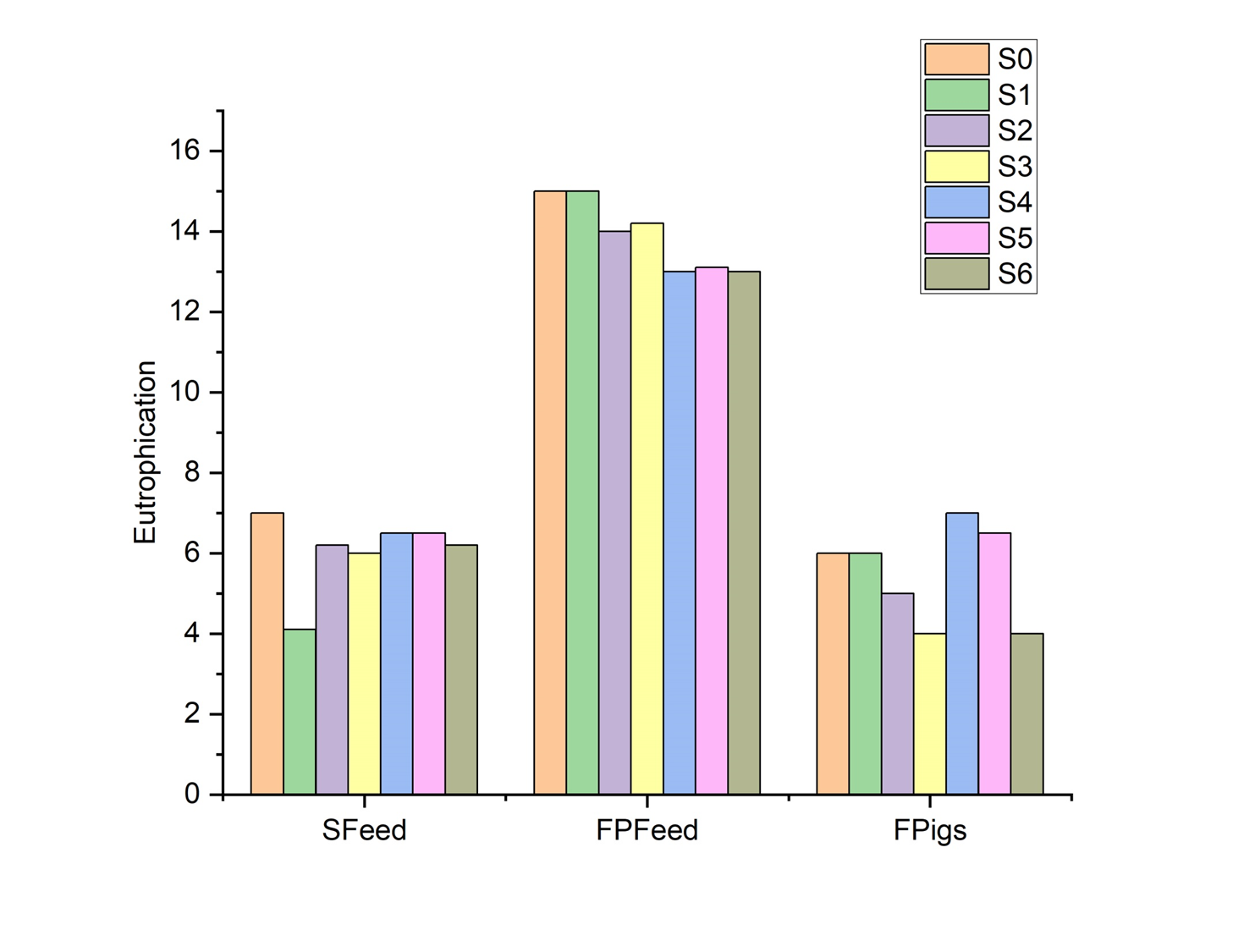Optimizing Nutrient Modeling in Organic Pig Production through Refining Feeding Strategies
Abstract
Organic pig farming practices are linked to significant ammonium losses, leaching of nitrates in sow pasture designs, and a reliance on imported proteins feed ingredients like soybean cake. Additionally, there is a shortage of information on leakage variables and models that take into consideration nutrient balancing for organic farming processes in ecological nutrient modeling methodologies. As a result, the current research was aimed at investigating feeding practices in sustainable pig farming using sophisticated nutritional modeling techniques. Six consuming circumstances were examined using a Eco balance analysis life cycle method: Reduced non-degradable protein in food sources for female pigs and porkers (S1), reduced proteins concentrations in food sources for female pigs and porkers (S2), and reduced the amount of compound food that female pigs and female pigs and porkers consume (S5 and S6, respectively). Typical production data were acquired, and information on organic production (nitrogen levels in manure, pigsty and residence ammonia emission factors) was found. Sucker, porkers, feed, compost, and inputs production were the six components that were taken into account and regulated properly. Five ecological impact categories were evaluated: land occupancy, Eutrophication potential (EP), Acidification potential (AP), Abiotic factors depletion (AD) of fossil fuels, and climate alteration (CA)(including changes in soil carbon).It was shown that in comparison to merely adding female pig, the feeding techniques had noticeably greater results when incorporating both female pig and developing piglets. The lowest amounts of compound feed to female pig and growing pigs were predicted to be responsible for the greatest reductions for the majority of the evaluated environmental effects.
References
Yue, S., Li, Z., Hu, F. and Picimbon, J.F., 2020. Curing piglets from diarrhea and preparation of a healthy microbiome with Bacillus treatment for industrial animal breeding. Scientific reports, 10(1), p.19476.
Tolosa, J., Rodríguez-Carrasco, Y., Ruiz, M.J. and Vila-Donat, P., 2021. Multi-mycotoxin occurrence in feed, metabolism and carry-over to animal-derived food products: A review. Food and Chemical Toxicology, 158, p.112661.
Groher, T., Heitkämper, K. and Umstätter, C., 2020. Digital technology adoption in livestock production with a special focus on ruminant farming. Animal, 14(11), pp.2404-2413.
Zhang, Q.F. and Zeng, H., 2022. Producing industrial pigs in southwestern China: The rise of contract farming as a coevolutionary process. Journal of Agrarian Change, 22(1), pp.97-117.
Ndue, K. and Pál, G., 2022. Life Cycle Assessment Perspective for Sectoral Adaptation to Climate Change: Environmental Impact Assessment of Pig Production. Land, 11(6), p.827.
Dale, B., 2019. Farming for system change: The politics of food sovereignty and climate change in Canada (Doctoral dissertation, University of Toronto (Canada)).
Kruger, S.D., Zanin, A., Durán, O. and Afonso, P., 2022. Performance measurement model for sustainability assessment of the swine supply chain. Sustainability, 14(16), p.9926.
Moyo, L.B., Simate, G.S. and Mutsatsa, T., 2022. Biological acidification of pig manure using banana peel waste to improve the dissolution of particulate phosphorus: A critical step for maximum phosphorus recovery as struvite. Heliyon, 8(8), p.e10091.
Blavi, L., Solà-Oriol, D., Llonch, P., López-Vergé, S., Martín-Orúe, S.M. and Pérez, J.F., 2021. Management and feeding strategies in early life to increase piglet performance and welfare around weaning: A review. Animals, 11(2), p.302.
Wang, L., Hu, Q., Wang, L., Shi, H., Lai, C. and Zhang, S., 2022. Predicting the growth performance of growing-finishing pigs based on net energy and digestible lysine intake using multiple regression and artificial neural networks models. Journal of Animal Science and Biotechnology, 13(1), pp.1-13.
Rauw, W.M., Rydhmer, L., Kyriazakis, I., Øverland, M., Gilbert, H., Dekkers, J.C., Hermesch, S., Bouquet, A., Gómez Izquierdo, E., Louveau, I. and Gomez‐Raya, L., 2020. Prospects for sustainability of pig production in relation to climate change and novel feed resources. Journal of the Science of Food and Agriculture, 100(9), pp.3575-3586.
Zira, S., Salomon, E., Åkerfeldt, M. and Röös, E., 2023. Environmental consequences of pig production scenarios using biomass from rotational trifoil leys as feed. Environmental Technology & Innovation, 30, p.103068.
Presto Åkerfeldt, M., Friman, J., Dahlström, F., Larsen, A. and Wallenbeck, A., 2022. Juice from silage in green bio refineries–a potential feed ingredient in liquid diets to weaned pigs. Acta Agriculturae Scandinavica, Section A—Animal Science, pp.1-7.
Friman, J., Lundh, T. and Presto Åkerfeldt, M., 2021. Grass/clover silage for growing/finishing pigs–effect of silage pre-treatment and feeding strategy on growth performance and carcass traits. Acta Agriculturae Scandinavica, Section A—Animal Science, 70(3-4), pp.151-160.
Keto, L., Tsitko, I., Perttilä, S., Särkijärvi, S., Immonen, N., Kytölä, K., Alakomi, H.L., Hyytiäinen-Pabst, T., Saarela, M. and Rinne, M., 2021. Effect of silage juice feeding on pig production performance, meat quality and gut microbiome. Livestock Science, 254, p.104728.
Bertasini, D., Battista, F., Rizzioli, F., Frison, N. and Bolzonella, D., 2023. Decarbonization of the European natural gas grid using hydrogen and methane biologically produced from organic waste: A critical overview. Renewable Energy.
Dione, M.M., Dohoo, I., Ndiwa, N., Poole, J., Ouma, E., Amia, W.C. and Wieland, B., 2020. Impact of participatory training of smallholder pig farmers on knowledge, attitudes and practices regarding biosecurity for the control of African swine fever in Uganda. Transboundary and emerging diseases, 67(6), pp.2482-2493.
Hu, Y., Hu, M., Jiang, H., Yu, P. and Yang, W., 2023. Co-liquefaction of livestock manure and food waste: Synergistic effects and product combustion performance. Applied Energy, 341, p.121073.
van Loon, M.P., Hijbeek, R., Ten Berge, H.F., De Sy, V., Ten Broeke, G.A., Solomon, D. and van Ittersum, M.K., 2019. Impacts of intensifying or expanding cereal cropping in sub‐Saharan Africa on greenhouse gas emissions and food security. Global change biology, 25(11), pp.3720-3730.
Rempelos, L., Baranski, M., Wang, J., Adams, T.N., Adebusuyi, K., Beckman, J.J., Brockbank, C.J., Douglas, B.S., Feng, T., Greenway, J.D. and Gür, M., 2021. Integrated soil and crop management in organic agriculture: a logical framework to ensure food quality and human health?. Agronomy, 11(12), p.2494.







